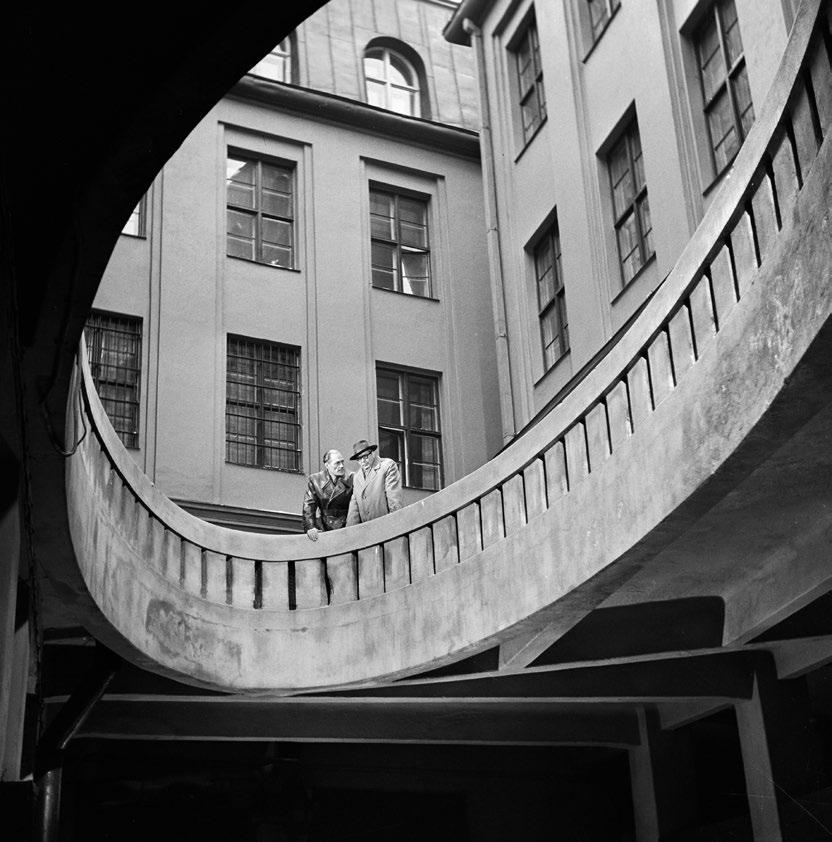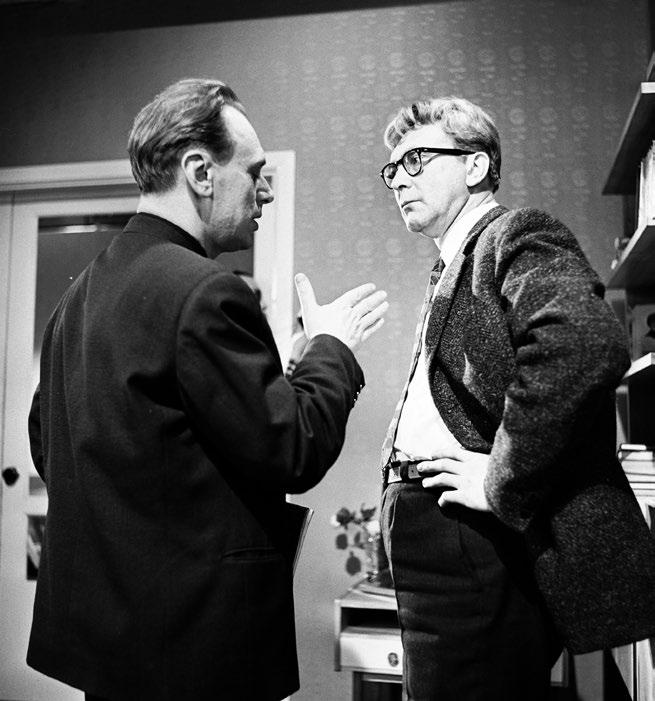
6 minute read
CLASSICS
The communist ideological struggle was here applied to veterans of the Great Patriotic War, or World War II as it is known outside Russia – the most honourable men in the Soviet Union.
Jaan Saul wrote after the premiere in Sirp ja Vasar: “Lapeteus is a modern look at the recent past, a complicated, fresh past, the discussion about it is still ongoing, the effects and consequences are still being argued about, the evaluation and the exact formulation of the period is still in the phase of shaping and reshaping.” 2
The film gains most of its original character from Kromanov’s way of storytelling though, not the theme. The psychological drama unfurls simultaneously on several timelines, telling the story of the decline of a conformist man, up to the moment when his frontline comrades tell him something that the audience has become more and more aware of as the film progresses: “People don’t have a grudge against you, but they don’t love you much either”. The decline from a hopeful builder of communism to a troubled careerist is shown in a reverse turn of events.
The Technical Side
ence with his films. These results could only be achieved by a few directors.
All this might not have come to be, if it weren’t for the film version of Paul Kuusberg’s 1963 novel “The Andres Lapeteus Case” that Kromanov, master of the psychological portrait, successfully brought to screen.
Themes In The Film
Paul Kuusberg could start on his novel about the disclosure of the Soviet personality cult only after the 20th Congress of the CPSU (Communist Party of the Soviet Union) in 1956, where Nikita Khrushchev held a speech in front of a closed hearing exposing and condemning the crimes of Stalin during his rule. The consequent book was well received in the climate of political thaw, and it attracted enough attention to be brought first to the stage in Vanemuine theatre in Tartu (premiered on the 21st of May 1964) and plans for the film version were set in motion at Tallinnfilm.
In essence, the theme of corruptive power wasn’t anything new in the cinema of Soviet Estonia: a film called Under One Roof had been released in 1962, about a power struggle in an ailing collective farm, and Traces in 1963, where the main character has an increasingly hard time remaining human and staying pure in the eyes of the party at the same time. But for the first time, these issues were brought to an urban environment in Lapeteus – to the streets of Tallinn, the capital of Soviet Estonia.
Ada Lundver plays Reet Lapeteus in the film. She is like like a breath of fresh air in the Soviet Estonian cinema –a woman who just wants to enjoy good life.
The intricacies of editing were pointed out in reviews by contemporaries like Mati Unt, Jaan Saul, Valdeko Tobro (“Kromanov uses mental-associative montage, the transitions from one episode to the next are meticulously planned, clean, graceful, and wholly logical at the same time.3”), as well as Eva Näripea, film scholar of the 21st century.4 Näripea’s work highlights the important role of the cinematographer Mihhail Dorovatovski in constructing the film’s meaning and creating

What Happened to Andres Lapeteus? was generally well received by both the audiences and the critics.
WHAT HAPPENED TO ANDRES LAPETEUS?
Premiere: 21st of March, 1966, Kosmos cinema, Tallinn

Length: 92 minutes, black and white
Production company: Tallinnfilm
Shooting locations: Tallinn and Narva metaphors in visual language, as well as associations with François Truffaut’s debut feature 400 Blows (1959), and the detective films of the 1940s-1950 by the likes of Billy Wilder, Otto Preminger, and Fritz Lang.

Directed by Grigori Kromanov; cinematographer Mihhail Dorovatovski; production designer Linda Vernik; screenwriter Paul Kuusberg; composer Eino Tamberg; producer Virve Lunt.

Cast: Einari Koppel, Ada Lundver, Heino Mandri, Ita Ever, Kaljo Kiisk, Uno Loit, Rein Aren, Ants Eskola, etc.
Ita Ever plays Helvi Kaartna in the film. Her role could be described as one of the most legendary depictions of kindness in Estonian cinema.
Just as important is the Neorealist approach chosen by Kromanov, ruling out the studio as a location and making sure that the film remains a faithful period piece of dirty times when no-one could be trusted, and a stained resumé could become an issue that led to expulsion from the communist party, or worse, a one-way ticket to a labour camp in Siberia.
This unpleasant and spooky atmosphere is a commendable joint effort from Kromanov, Dorovatovski, and production designer Linda Vernik. Luckily it helps to keep the film at just the right distance from the audience, working as a reminder of the times that are currently being monstrously revived just a few hundred kilometres east of Tallinn. The atmosphere of fear, snitching, snooping around, and grovelling is effectively opposed to rare positive characters, who, in the spirit of the times, are depicted by the last honest communists.
It is worth paying attention to the details – the furniture, objects on a desk, the way glances are exchanged, how hands are used, and how all of this is presented to us on camera. What Happened to Andres Lapeteus? is a film made for discovering minute details, proof of a precisely thought-out author’s signature style that can be used to characterise all of Kromanov’s films.
Work Of The Actors
Every film’s success is dependent on casting, and thanks to Kromanov’s personal experience as an actor he was great at picking the players for his films. Kromanov’s interest in psychology is reflected in the way he matches the role with the actor. Although the critics ended up being quite harsh towards Einari Koppel who played Lapeteus – mainly because the emphasis of the film is different from Kuusberg’s book, where Lapeteus is a wholly positive character until the end –, Kromanov was clearly not interested in recreating the feeling of the novel. Instead, he changed the title and turned the spotlight on the moral decline of Lapeteus, so that everyone could make up their own mind which false decision was instrumental in the disintegration of this steadfast individual.
Everything seems so hopeful at first, when a company of war heroes return home from the front. Slick Haavik (Rein Aren) is ready to do anything to become a party functionary. Simple guy Pajuviidik (Kaljo Kiisk, the most prolific Estonian feature film director of all time) is an honest and funny man of many trades, but has penchant for alcohol and various rackets. Roogas (Uno Loit) is trustworthy and loyal, his biggest sin is a wife who fled to the West together with the Germans during the war, making him a suspicious element in the eyes of the governing power. Põdrus (Heino Mandri) is the voice of reason, a man of principle who gets crushed by the machine, because he is not ready to go against his conscience. Helvi Kaartna (Ita Ever) is the only positive figure in this story, always true to herself, one of the most legendary depictions of kindness in Estonian cinema. Unfortunately, she has to use her kindness in the interest of the criminal political establishment.
Grigori Kromanov is known as a director who was great at picking the actors for his films. Einari Koppel as Andres Lapeteus and iconic Ada Lundver as his wife Reet.
Their opposites are Järven (Ants Eskola) – shaper of the post-war society, a dogmatic Stalinist, in both word and deed. A true embodiment of evil. And the wife of Andres Lapeteus, Reet (Ada Lundver), described by Mati Unt as a “provincial Marilyn”, who is a complete contradiction in the whole of Soviet Estonian cinema.
In Estonian cinema of the 1960s, she is the only character who simply wants to live well and enjoy life. It’s a concept that didn’t really fit the Soviet ideology, and is not shown in very good light here, but essentially, Reet is like a breath of fresh air and a complete departure from the Soviet Estonian film women with headscarves and buttoned-up cardigans. Her role


The Words Of The Director Grigori Kromanov
before the beginning of the shoot, 1965: “The story of Andres Lapeteus grabs me personally. The story is current, and forces us to ask: who are we, what has happened, or is about to happen to us? The film has to be able to answer this. Can we remain truthful in every situation, even in small matters of life? Can we stay true to ourselves and always see our life goal?” forces the Soviet cinemagoer to analyse conversations about rape, adultery, and deception. All three should be labelled amongst the things that “do not exist in Soviet Union”, but somehow these themes slipped into the film and became immortal thanks to Kromanov, hinting at their existence with its fair share of participants and victims in the vast USSR. Ada Lundver is magnificent as a bourgeois party hostess, and the house party scenes are certainly among the most memorable and entertaining in Estonian film history.



The Importance Of An Open End
Legendary Estonian film critic Jaan Ruus has said: “There were no open ends in the Soviet cinema. Evil was punished according to the party line, but now, suddenly Kromanov leaves it open.”5
In this solution, we see the director’s boldness not to follow the usual tropes of his first film; and his attempt to lead the audience towards a more active cinema experience than was usually assumed. The biggest wonder of What Happened to Andres Lapeteus? lies in exactly that – trying to get the audience to think along. Although it is a film that glorifies the red principles of the red era to a degree, there is enough room between the lines for the viewers to piece the puzzle together themselves. It is an opportunity offered by only very few authors of Soviet cinema, and Kromanov is certainly among them. EF










